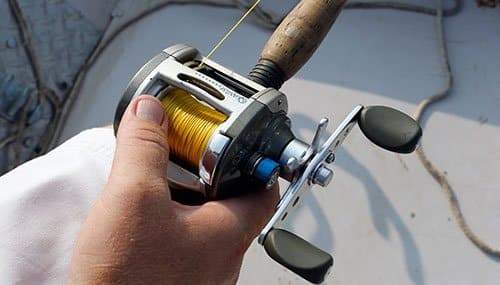A little tinkering brings reels back to life
ON 05-13-2020

May 13, 2020
Jeff Williams
Editor, Arkansas Wildlife Magazine

LITTLE ROCK — Outdoorsmen have as much fun tinkering, fiddling and piddling as they do hunting, fishing or looking for wildlife.
They break down rifles and shotguns, clean and oil the mechanisms, and put the pieces back together. They clean binoculars and cameras so they’ll be ready for the next sighting of a favorite critter. And they tear into fishing reels to make them spin smoother than the day they came out of a box.
There’s probably a gene for taking things apart. If you’ve got it, you love to open a reel to see how it works, especially if it’s old and crusty.
Years ago, I was driving to a float-fishing trip when I spotted a yard sale. This one featured the usual out-of-date items, from bread boxes to Brownie cameras, but one table was loaded with reels. Like most fishermen, I have reels to the gills, but I liked the idea of buying a couple and putting them back into service.
I picked up a Cardinal 553 and a Cardinal 763 for $10. Neither was obviously damaged (the 763’s handle was attached with a replacement screw, although it appeared serviceable). The action of each was sluggish and they were dinged up. I packed them away, went on with the trip and came back to them months later.
Parts and Pieces
If you’re not familiar with the process, yard sale reels are a great place to start. You’re not investing a lot of money and most older reels are pretty basic. Check websites for reel schematics; you’ll be amazed at the number of schematics for obscure reels that have been posted.

Reels are loaded with parts, especially washers. Perhaps the best advice for anyone who plans to breakdown a reel is: Keep the parts in order (this is where the schematic can come in handy). Create a system (number the parts, go by order of disassembly, whatever works) that will help put them back the way they were. Owners’ manuals (check the internet) may give tips about how to disassemble or reassemble.
Now that digital cameras are on everyone’s phone, it’s a great idea to take pictures of the inside of the reel as soon as it’s open and take plenty of pictures along the way. These images could be vital if the parts just won’t fit later.
A good scrubbing
Degrease everything. It’s the grit inside a reel that causes it to grind when it’s cranked, sort of like dirty oil in an engine. Even a cheap, old reel turns much more smoothly after cleaning. Just put the parts in a shallow bowl with degreaser and let them soak. The degreaser will do most of the work for you if it’s given time.
With an old toothbrush or swabs, wipe away gunk from gears, washers and the “worm shaft,” a perfectly descriptive phrase. Clean the inside and outside of the housing because dirt left there will find its way into cogs. The goal is to remove anything that could hold grime.
Use light greases and lubricants on the worm screw and gears – anything that moves. An owner’s manual might explain how to reach the bearings, which should receive a few drops of oil. Don’t overdo it with the oil and grease, though. Too much lubricant can dry and cake up around bearings and gears, collecting the sort of dirt and grime you just cleaned.
Besides the two reels mentioned above, I found a Browning rod and reel at my feet while wade fishing in the Buffalo River several years ago. The combo was covered in all sorts of growths. None of the rod was visible,and I knew the reel only by its shape.
As beat up and hopeless as that rod and reel looked, they are in use to this day. A cleaning removed the crud from the rod, light sanding restored the cork handle, and the reel works like a charm after a thorough cleaning and oiling. Fresh electrical tape straps the reel to rod.
Keep it clean
Maintaining reels on a regular basis will keep them out of your future yard sales.
Oil the bail assembly at the hinge where the bail flips over to cast and the crank where the handle meets the reel body. Just take the handle out of the reel and drop just a little oil where the handle goes.
With baitcasting reels, oil the level wind and put a drop of oil on the bearings – just a little bit. Pull the spool out and wipe around it. Keep it clean and oil those bearings.
After a while, no amount of cleaning will keep a reel from eventually needing some professional help. Bearings and gears wear, there’s no way around it. But keeping everything clean is a sure way to prevent an early visit to the repair shop.
The original version of this story appeared in Arkansas Wildlife magazine in 2010. Visit www.arkansaswildlife.com to learn more about the magazine and how to subscribe.
Recent News

Waterfowl Report: Better Conditions Greet Hunters
Dec. 12, 2025

Lonoke hatchery staff making room for megabass
Dec. 11, 2025
Subscribe to Our Weekly Newsletter E-mails
Don’t miss another issue. Sign up now to receive the AGFC Wildlife Weekly Newsletter in your mailbox every Wednesday afternoon (Waterfowl Reports are published weekly during waterfowl season and periodically outside the season). Fishing Reports arrive on Thursdays. Fill in the following fields and hit submit. Thanks, and welcome!
